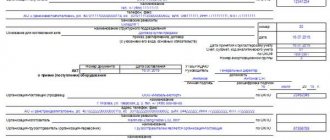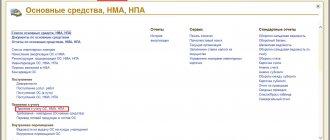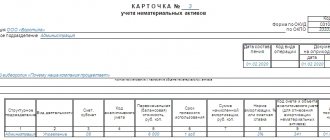Sample of registration of the act of acceptance and transfer of fixed assets
Filling out the first page of the act
- At the beginning of the document, space is allocated for its approval by the heads of the enterprises between which the acceptance and transfer of fixed assets takes place, indicating their positions and the date of approval.
- Next, enter data about the recipient organization: its full name, address, information about the current account and the bank in which it is opened. Similarly, information about the company that transfers the property is entered into the form.
- In the line “Grounds for drawing up the act” a link is given to the agreement - its number and date of creation.
- After this, two more dates are entered into the act: acceptance of the fixed asset for accounting and its write-off. This also includes the account number through which all actions with this property take place and its inventory, factory, and depreciation numbers.
- At the end of the registration of this part, the act is assigned a number, the date of its preparation is indicated, the name of the transferred property, the location of its actual location at the time of acceptance and transfer, and the manufacturing organization are written.
All other information is entered as needed.
Filling out the second page of the act
The second page of the act includes three tables:
- The first contains information about the condition of the fixed asset at the time of acceptance and transfer: date of release, commissioning, repair, actual time of use, amount of depreciation, residual value and purchase price under the contract.
- The second table includes information about the object as of the date of acceptance for accounting: cost, remaining useful life and method of calculating depreciation.
- The third table concerns some features of the property, including the presence of precious metals in it.
Filling out the commission decision and signatures of the parties
The next part of the document includes the date, as well as the results of tests of the transferred property and the conclusion of the commission present at the acceptance and transfer.
If there are any attachments to the document (for example, an expert’s opinion), this must be noted in a separate paragraph.
At the end, the act is signed by all members of the acceptance commission, as well as managers and chief accountants of enterprises.
Current as of: September 11, 2021
We talked about the primary accounting documents used to document transactions with fixed assets in our consultation. We will tell you more about form No. OS-1 in this material.
What to pay attention to when drawing up a deed
Information can be entered into the document either on a computer (if an electronic form is available) or by hand (with a ballpoint pen, but not a pencil).
An important requirement that must be met: the presence of signatures of heads of organizations or representatives acting on their behalf (the use of facsimile signatures is unacceptable). There is no strict need to certify the form using stamps, since from 2021 legal entities have the right to use seals and stamps in their work only on the condition that this norm is enshrined in their internal regulations
There is no strict need to certify the form using stamps, since from 2021 legal entities have the right to use seals and stamps in their work only on the condition that this norm is enshrined in their internal regulations.
The document is created in at least two copies (one for each party to the transaction), but additional copies can be made if necessary.
Filling out a unified form for the acceptance and transfer of groups of objects
The OS-1b act form consists of 4 pages.
Information contained in the introductory part of the unified form:
- data on organizations concluding a transaction for the acceptance and transfer of groups of objects: full name, OKPO code, bank account details, legal address, contact telephone number;
- information about the basis for drawing up the document (agreement for the acquisition of a group, an order from the manager on commissioning);
- day of reflection in the accounting documentation;
- title of the form, its number and date of preparation;
- purposes of transfer (sale, donation, inclusion in fixed assets);
- name of the organization producing the objects;
- background information about the participants in shared ownership (if any).
In the OS-1b form, information about a property owned by 2 or more enterprises is recorded in proportion to the company’s share in the common property right.
And on the page of the act, in the “For reference” section, information about the participants in shared ownership is entered.
The following pages of the OS-1b act form (from 2 to 4) are presented in the form of tables.
Second page
Information contained on the second page of form OS-1b:
- names of transferred fixed assets;
- factory, OS inventory number, depreciation group;
- year of manufacture, year of start of operation and major overhaul (if any).
The table is signed by members of the commission who receive the group of funds.
Below in the OS-1b act, the date of the activities carried out by the commission to inspect the main objects and the final conclusion are stated.
Finally, the applicable useful life of the specific property is indicated.
Technical documentation for each OS object is attached to the act; its presence is recorded at the bottom of the page.
Third sheet
The third page of the OS-1b form contains the information:
- actual service life of the property, depreciation and residual value (for used equipment);
- the cost of purchased objects for 1 unit and for the entire set of fixed assets;
- useful life of the asset, depreciation method.
This page of the unified form OS-1b is signed by the responsible employee of the submitting organization, the date and transcript of the employee’s signature are recorded.
Important! The chief accountant puts a mark on the inventory card about the disposal of fixed assets from the balance sheet of the enterprise
Fourth page
The following information is entered on the fourth page of the OS-1b form:
- brief description, characteristics of the group of transferred property;
- content of precious metals in fixed assets in the object, their name, weight, quantity, item number, unit of measurement.
The sheet is signed by the receiving party.
The responsible specialist of the recipient organization affixes his autograph as confirmation of acceptance of the objects, including for safekeeping.
If an employee acts on behalf of the company under a power of attorney, then the details of the trust document are recorded in specially designated fields.
At the end of the OS-1b form, the chief accountant of the company signs for the opening of an inventory card for the OS object.
Sample
Below we offer a unified form OS-1b and a completed sample document in Excel format for free.
If you still have questions about filling out the transfer and acceptance certificate, you can ask them through the comments at the bottom of the article.
act of acceptance and transfer of a group of fixed assets OS-1b - excel.
filling out form OS-1b - excel.
Completed example of act OS-1b:
When selling
Documentation for the sale of objects is filled out on the date of transfer of property rights to the buyer (the day of signing the purchase and sale agreement for fixed assets).
The acceptance certificate is drawn up in 2 copies - for the seller and the buyer. The basis for the act is also a signed contract between organizations.
The characteristics that unite property into groups include the purpose of the transfer and the manufacturing company. The goal is to sell, but the manufacturers may be different. When selling, for example, printers and copiers, from different manufacturers, separate acts are drawn up for each group of office equipment.
When the donating organization writes off a group of fixed assets, the accounting department stops accruing depreciation and property tax (if the former property was taxed).
The recipient company, on the contrary, begins to charge depreciation from the date of acceptance of the fixed asset into operation, as well as property tax.
Unified form OS-2. Sample filling.
The invoice for internal movement OS-2 is filled out in 3 copies, one of which is kept by the person who completed the movement, the second is intended for the receiving party, and the third must be transferred to the accounting department.
In the header of the form on the front side of the invoice for internal movement, fill in the name of the organization, the deliverer and receiver of fixed assets, the form code according to OKUD, the code according to OKPO, the document number and the date of its preparation.
The main part of the OS-2 act consists of a table that contains 7 columns:
- OS number in order;
- OS object name;
- date of purchase;
- inventory number;
- number of objects;
- unit cost;
- cost of everything.
Below the table there are lines to characterize the technical condition of the object. Next come the signatures of the person handing over and receiving the object: position, signature and transcript of the signature, personnel number, date. The unified form OS-2 is signed by the chief accountant.
In order to quickly and without errors fill out the invoice according to form OS-2, download and study the sample filling:
Features of drawing up OS-1 for gratuitous transfer
When transferring property free of charge, which was already listed as a fixed asset, the receiving party receives an OS-1 act completed by the donor. The document has already filled in the relevant sections with accounting data by the transferring party (depreciation group, inventory number, etc.).
But in order to accept an object for accounting, the receiving party is obliged to indicate its credentials in OS-1. Therefore, she must draw up an additional copy of the act based on the act of the transferring party and technical documentation (in particular, a technical passport, operating instructions, etc.).
The resulting OS-1 act will be an analogue of the TORG-12 document.
How many copies do you need?
When transferring previously used property to a new owner, 2 copies of the act are drawn up (1 for each party). The document is drawn up by the previous owner of the OS object.
Each copy of the acceptance certificate is subject to approval by the directors of both companies; proper technical documentation for the OS is attached to the certificate (registration certificate, construction plan, operating instructions).
If one of the parties to the transaction is a budgetary institution, there should be 3 copies of the document. Another package of documents is drawn up for the Federal Property Management Agency.
Signatures are affixed not only by commission members, but also by directors of state enterprises. The clause on state registration of rights is filled out only when transferring real estate.
Sample filling - OS form 1 and its features
OS 1 – you will find a sample filling below, it is compiled on 3 pages. Before using the sample filling - form OS 1, you should understand that such a document is created only for registering a new fixed asset. When selling fixed assets, in the sample of filling out OS 1 (transfer and acceptance certificate), the receiving party should be sure to rewrite the information about the conclusion of the acceptance committee in the appropriate column.
The main feature for the sample of filling out OS 1 from the lessee is that a note is made in the act that the received object is being put into operation under a leasing agreement. Please note: this agreement must stipulate that the fixed asset is transferred to the lessee for balance.
Due to the fact that after the adoption of the new law on accounting since 2013, the use of unified forms is not mandatory, each accountant can edit the form of such a document in his own way. When adjusting the OS-1 transmission acceptance certificate, you should remember in which columns to display the required information.
Page 1 states:
- Certificate approval stamps. When purchasing/creating a new OS, the certificate of approval is not affixed by the donating organization.
Important! The stamps of the unified form OS-1 (the sample filling will help you figure this out) contain such details as the place of printing. At the same time, the seal is not named among the mandatory details of the primary accounting document established by
2 tbsp. 9 of the Federal Law of December 6, 2011 No. 402-FZ “On Accounting”. That is why, if an organization (receiver or deliverer of OS) has officially refused to use a seal (Federal Law No. 82-FZ dated April 6, 2015), it is not necessary to affix a stamp. This is confirmed by the letter of the Ministry of Finance of Russia dated 08/06/2015 No. 03-01-10/45390.
- Information about the organization that receives the OS.
- Information about the delivering organization. This attribute is filled in if the object is transferred as an OS. This is not required for new and independently created objects.
- Accounting information, including the account of the object, the date of acceptance/write-off of the object from the register.
- Information about the fixed asset itself: name, purpose, model, brand, location, information about the manufacturer, inventory and serial numbers, depreciation group number, etc.
The second page of the act contains 3 sections.
Section 1 is filled out only for objects that were used as fixed assets based on the data of the donating organization. It contains information about the asset as of the date of transfer, including the date of release, commissioning, overhaul, actual service life, useful life, as well as information on depreciation accrued by the former owner and the residual value of the fixed asset.
Section 2 is filled out only by the recipient organization in one (its own) copy. This provides information on the depreciation procedure for an object: its original cost, the useful life established by the new owner, as well as the method and rate of depreciation.
About depreciation of fixed assets in accounting, see:
- “Formula and example of the reducing balance method of depreciation”;
- “How to correctly apply the cumulative depreciation method?”
Section 3 contains a brief individual description of the fixed asset item. All its fixtures and accessories are reflected here, the content of precious metals (if present in the composition) and other characteristics of the object are indicated.
On the third page of the document:
- data on the acceptance of the OS by the commission (whether or not the object meets the technical specifications, whether it requires modification);
- signatures of competent persons: members of the acceptance committee and persons who handed over and accepted the object.
At the very end, accounting marks are added:
- the transferring organization - that the disposal of the object is reflected in the inventory card (filled out only when transferring fixed assets between owners);
- the receiving party - about opening an inventory card on the OS or about a corresponding entry in the inventory book.
Filling procedure
The submitting organization fills out the following fields on the title page of the OS-1 form:
- The stamp “APPROVE” and details of both parties.
- Act number and date.
- Dates of receipt and sale.
- Depreciation group number.
- Inventory and serial numbers.
- Object name.
- Location at the time of transfer.
On the second page you should indicate the following information:
- Date or year of issue.
- Initial date of entry into service.
- Actual service life in years or months.
- Useful life determined in accordance with the Classification of fixed assets included in depreciation groups, approved. Decree of the Government of the Russian Federation dated January 1, 2002 No. 1 (as amended on December 27, 2019).
- The amount of depreciation accrued up to the date of transfer.
- Residual value (purchase price excluding VAT minus accrued depreciation).
- Contract price (the amount for which the fixed asset was sold, including VAT).
- Brief individual characteristics data.
This is what a sample of filling out the OS-1 form looks like with an example of selling an air conditioner:
- book value—RUB 271,666.67;
- depreciation group - 3;
- useful life - 37 months;
- amount of accrued depreciation—RUB 7,342.34;
- sales price—RUB 330,000.00.
On the third page of the OS-1 form, data on the test results and signatures of the responsible persons of the transmitting and receiving parties are filled out.
A separate protocol on the acceptance of the object for registration is drawn up on the results of the commission’s work.
Which form should I use?
There are several types of unified forms for acceptance of fixed assets:
- OS-1 - for single OS;
- OS-1a - for one building and structure;
- OS-1b - for several objects (homogeneous), with the exception of buildings and structures.
Do not confuse these forms when putting the OS into operation.
You can also use a self-developed form in your work. The main point in this situation is the approval of the form by order of the head of the enterprise and the presence of all required details.
In practice, there are times when none of the listed forms are suitable. For example, the receipt of a fixed asset by the lessee company under a leasing contract. This application cannot be processed using standardized forms; the only solution is to develop your own form. All necessary data is entered into the document in accordance with the Federal Law of December 6, 2011 No. 402-FZ (Article 9).
In what cases and when is it used?
The unified form of the OS-1b act is used by the recipient organization for:
- inclusion of property in the form of a group of homogeneous objects in the fixed assets (their accounting and commissioning), acquired under sales contracts or for cash;
- when registering a financial lease (when the property is on the balance sheet of the lessee);
- when unaccounted for property is discovered during the inventory or manufactured in-house or with the help of contractors;
- exclusion from the OS of a group of objects during exchange, sale, donation, or transfer to another enterprise.
Important! The donating organization issues the OS-1b form only when exchanging, selling, or gratuitously transferring fixed assets. For objects that do not require installation, the start of operation occurs at the time of purchase
If installation is necessary, then inclusion in the OS is carried out after the equipment assembly process. Initially, the property is accepted according to the OS-14 act, after which they are transferred for installation on the basis of the OS-15 form
For objects that do not require installation, the start of operation occurs at the time of purchase. If installation is necessary, then inclusion in the OS is carried out after the equipment assembly process. Initially, the property is accepted according to the OS-14 act, after which they are transferred for installation on the basis of the OS-15 form.
conclusions
If it is necessary to formalize the transfer and acceptance of a group of objects that have homogeneous characteristics, then it is more convenient to fill out not separate acts for each fixed asset, but to fill out a single form in which data for the entire group will be combined.
You can draw up a transfer deed in free form, or use the unified OS-1b form. The form is presented on 4 pages and reflects a complete set of information about the parties to the process and the transferred equipment or other property.
Form OS-1b cannot be used to formalize the transfer of real estate.
The article describes typical situations. To solve your problem, write to our consultant or call for free:
+7 Moscow — CALL
+7 St. Petersburg — CALL
+7 Other regions - CALL
It's fast and free!
Key points when filling out form OS-1
The act applies to primary documentation, for which strict requirements have been abolished since 2013. Therefore, today, enterprises and organizations have every right to draw up a document in any form, use a template approved within the company, or fill out a previously mandatory standard unified form. The last option is convenient because it includes all the necessary information; you do not need to rack your brains over the structure and content of the document.
The required information in the act includes:
- creation date and number;
- details of enterprises;
- the name of the fixed asset, as well as everything related to its quality and quantity.
If the recipient of the property has no claims against the supplier, this must be noted; if such claims exist, they must be described in detail.
What is form No. OS-1a used for?
Form No. OS-1a is the Certificate of Acceptance and Transfer of a Building (Structure). Based on its name, form No. OS-1a is used when registering and accounting for transfer and acceptance operations of buildings and structures for:
- inclusion of objects in the OS and accounting for their commissioning - in relation to buildings and structures received as a result of the acquisition for a fee in cash, commissioning of completed buildings (structures, built-in and attached premises);
- disposal from fixed assets in cases of transfer (sale, exchange, etc.) to another organization.
Act No. OS-1a in Excel format can be found here.
Please remember that along with form No. OS-1a for accounting for the reception and transfer of fixed assets, Resolution of the State Statistics Committee of January 21, 2003 No. 7 also approved the following forms:
- Form No. OS-1 - for OS objects (except for buildings and structures);
- Form No. OS-1b - for groups of fixed assets (except for buildings and structures).
Like other forms of primary documentation for accounting for fixed assets, form No. OS-1a is not mandatory for use (Information of the Ministry of Finance No. PZ-10/2012). This means that an organization for the above purposes can either use unified primary forms or develop the necessary forms independently. It is only necessary that the forms of primary accounting documentation used be approved in the Accounting Policy of the organization for accounting purposes.
Let us recall that when developing forms of primary documents on your own, it is necessary that such forms contain at least the following details (Part 2 of Article 9 of the Federal Law of December 6, 2011 No. 402-FZ):
- name of the primary document;
- date of document preparation;
- name of the organization that compiled the primary document;
- content of the fact of economic life;
- the value of the natural and monetary measurement of an economic fact, indicating the units of measurement;
- the names of the positions of the persons who made the transaction, operation and who are responsible for its execution;
- signatures of the above persons, their surnames and initials.
If the organization uses form No. OS-1a, for instructions on how to fill it out, you can refer to Resolution of the State Statistics Committee of January 21, 2003 No. 7, by which this form was approved.
Form No. OS-1a is drawn up in at least 2 copies and approved by the heads of the recipient organization and the delivery organization. Taking into account the peculiarities of registering rights to real estate, in the act in form No. OS-1a it is necessary to fill in the details “State registration of rights”.
We remind you that even if the ownership of a real estate property is not registered in the prescribed manner, but the property is already in operation, it must be accounted for in a separate subaccount to account 01 “Fixed Assets” and depreciated in the general manner from the month following the month of acceptance for accounting (p .p. 52, 61 of the Order of the Ministry of Finance dated October 13, 2003 No. 91n, p. 21 PBU 6/01).
Similarly, in tax accounting, depreciation of fixed assets does not depend on the fact of state registration of the right (clause 4 of Article 259 of the Tax Code of the Russian Federation).
Section 1 “Information on the condition of the object on the date of transfer” is filled out in form No. OS-1a for those objects that were previously in operation. This data is for informational purposes only.
And section 2 “Information about the object as of the date of acceptance for accounting” is filled out only by the recipient organization of the fixed assets object in its own copy.
If a building or structure is owned by two or more organizations, then data about such an object is reflected in the Act in proportion to the organization’s share in the common property right. In this case, on the first page of the Act, in the “For reference” section, information about the participants in shared ownership and their shares is indicated.
When transferring an OS object from one organization to another, a special document must be drawn up. This document is an act in form OS-1. You can learn more about it from the following article.
What is the OS-1b form
This form is an act containing information on the acceptance and transfer of groups of fixed assets.
IMPORTANT! This act does not apply to buildings and structures. For them, the OS-1a form is used
The movement of individual fixed assets is reflected in the OS-1 act.
The unified form OS-1b, as well as 2 other varieties of this form, was approved by Decree of the State Statistics Committee of the Russian Federation dated January 21, 2003 No. 7. However, it is not mandatory for use and can be replaced by another document of similar content, developed independently.
Having such an act in hand, you can perform the following operations:
- on the transfer of fixed assets between counterparties;
- entering objects into fixed assets;
- disposal of fixed assets.
To learn about the specifics with which fixed assets are accepted for accounting under the simplified tax system, read the article “Procedure for purchasing fixed assets under the simplified tax system (nuances).”
Form OS-1b can be downloaded on our website.
Unified form No. OS-1 - Certificate of acceptance and transfer of fixed assets
> > > August 26, 2021 Unified form OS-1 - you can download a sample form on our website - is the basis for capitalizing fixed assets and placing them on the organization’s balance sheet. Let's try to figure out how to fill out the unified form OS-1.
Documents and forms will help you: Find out how practicing accountants accept fixed assets for accounting under different taxation systems - find out on our forum. For example, you can find out about the nuances of how to purchase OS in installments with a simplified tax system of 15%. The unified form OS-1 “Act on the acceptance and transfer of fixed assets (except for buildings, structures)” was approved by Decree of the State Statistics Committee of the Russian Federation dated January 21, 2003 No. 7. This form can be found on our website.
Read about the use of independently developed document forms in the material. The transfer acceptance certificate OS-1 is intended for registration:
- disposal of fixed assets upon their transfer to another organization (sale, exchange, etc.).
- inclusion of objects in fixed assets and accounting for their commissioning;
The exception is cases when the acceptance and transfer of objects and their commissioning must be formalized in accordance with current legislation in a special manner.
If there is an acceptance and transfer of a fixed asset between its former owner and the new owner, the act is drawn up in 2 copies: one for the transferring party, the other for the receiving party. In this case, it is compiled by the donating organization. Both copies are approved by the heads of the recipient organization and the donating organization.
The act is also accompanied by technical documentation related to the OS object. When purchasing a new operating system, which is a product for the seller, or when introducing an object that the organization created itself, only 1 copy of the act is drawn up. OS 1 – you will find a sample filling below, it is compiled on 3 pages.







